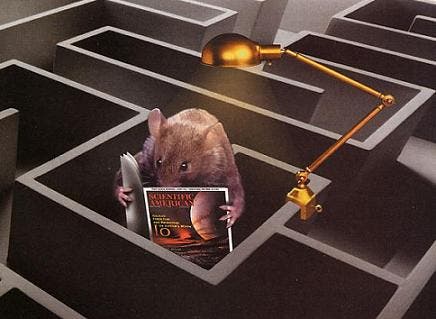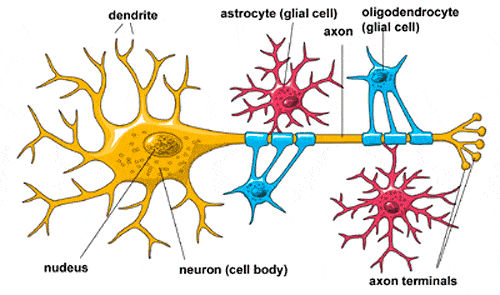Oh, boy. This week’s freaky science story comes from the University of Rochester Medical Center in New York where researchers grafted mouse pups with human glial cells. Within one year, half the brain cells of the by now adult mice were human. A study made last year by the same team suggests that mice whose brains contain human glial cells are smarter, while another experiment seems to indicate that mice with defects like uninsulated nerves can repair these nerves if human brain cells are inserted.
The overlooked glia

It’s important to set one thing straight: the mice still kept their 100% originally sourced neurons. It’s the glial cells that were human. Although there are about 100 billion neurons in the brain – the human one – there may be about 10 to 50 times that many glial cells. So, why haven’t you heard about them before if they’re so important? You know how fads come and go…
Sure, neurons are the rock stars because they have firing ability and are responsible for all the signaling that goes inside the brain. Without glial cells, however, neurons would never be able to function. There are five types of glia:
- Astrocyte (Astroglia): Star-shaped cells that provide physical and nutritional support for neurons: 1) clean up brain “debris”; 2) transport nutrients to neurons; 3) hold neurons in place; 4) digest parts of dead neurons; 5) regulate content of extracellular space
- Microglia: Like astrocytes, microglia digest parts of dead neurons.
- Oligodendroglia: Provide the insulation (myelin) to neurons in the central nervous system.
- Satellite Cells: Physical support to neurons in the peripheral nervous system.
- Schwann Cells: Provide the insulation (myelin) to neurons in the peripheral nervous system.
Steve Goldman of the University of Rochester Medical Center in New York extracted infant glia from donated human embryos and injected these into the brains of mouse pups. Soon enough, the glia started developing into astrocytes, which strengthen the connection between neuron connections called synapses. Human astrocytes are 10 to 20 times the size of mouse astrocytes and carry 100 times as many tendrils.
Taking over

Initially, some 300,000 human glia were inserted, but by the end of the year, the mouse had 12 million. This means that nearly all of the mouse’s native glia had been displaced.
“We could see the human cells taking over the whole space,” says Goldman. “It seemed like the mouse counterparts were fleeing to the margins.”
But do the human astrocytes in the mice actually behave as in the human brain or does the environment regulate them?
“That the cells work at all in a different species is amazing, and poses the question of which properties are being driven by the cell itself and which by the new environment,” says Wolfgang Enard of Ludwig-Maximilians University Munich in Germany, who has shown that mice are better at learning if they have the human Foxp2 gene, which has been linked with human language development.
This question will definitely be very interesting to answer. In a parallel experiment, Goldman and team inserted human glia once more into the brains of mice pups, only this time these bore a defect. The mice were poor at making myelin, the protein that insulates nerves. Once again, the immature glia developed quickly, but this time something amazing happened: many of the human glial cells matured into oligodendrocytes, brain cells that specialise in making the insulating material. Somehow, the glia recognized the defect and compensated.
[RELATED] Scientists engineer ‘super’ mice
Multiple sclerosis is a terrible disease in which the myelin sheath is damaged, and the findings suggest that glia therapy might render positive results. In fact, Goldman applied for permission to treat MS patients with the glial progenitor cells, and hopes to start a trial in 12 to 15 months.
Is this still a mouse?
![Image: Flickr // angeladellatorre]](https://cdn.zmescience.com/wp-content/uploads/2014/12/Folded-cortex.png)
The same team made a similar experiment last year, only the human glia they inserted were mature. These became integrated into the mouse brain, but didn’t develop further or expanded in numbers. But here’s the interesting part. In a standardized memory test, mice remembered a sound associated with a mild electric shock for four times as long as other mice when they heard the sound, suggesting their memory was about four times better.
“These were whopping effects,” says Goldman. “We can say they were statistically and significantly smarter than control mice.”
Next, to further determine how human astrocytes affect things like intelligence, memory or learning, Goldman will be grafting the same immature human glia into rat brains. Rats are smarter than mice, so it should be interesting to follow how the humanized rats respond.
Is this a super mouse? Is it a mouse anymore? Is it just a super smart mouse? Well, let’s leave it to Goldman:
“This does not provide the animals with additional capabilities that could in any way be ascribed or perceived as specifically human,” he says. “Rather, the human cells are simply improving the efficiency of the mouse’s own neural networks. It’s still a mouse.
Findings appeared in the Journal of Neuroscience.






